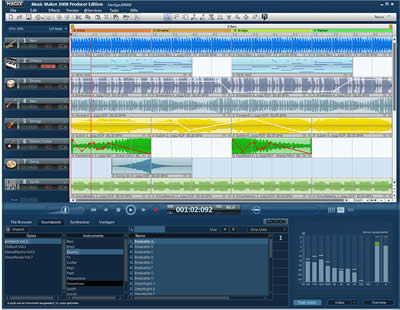|

Magix Music Maker Helps You Make Magical MusicBy Jim Bray Thanks to computers there’s little, if anything, that once was done in professional environments that can’t now be done in the home studio or office, and this is opening up new opportunities - and new challenges - for creative people. Such is the concept behind Magix Music Maker. Magix has been around for quite a while. In the past I've reviewed the handy Audio Cleaning Lab software I use often when I'm capturing old albums and stuff and burning them onto a digital disc. A computer and its software won't turn a hack into a new Frank Capra or Pete Townshend, of course, but they can help creative people do their work more easily and quickly. Music Maker 14 is where the musical rubber meets the virtual road, so to speak – at least so far as really creating that musical masterpiece is concerned. It’s a complete MIDI music studio where you can craft your own musical compositions (or learn to rip off someone else's, which I'm sure isn't what Magix intends with the product). My big problem is that, as mentioned above, no amount of software is going to turn a hack into a genius and my attempts at reviewing Music Maker were an ugly reality check during which I realized that on the hack/genius scale I'm not nearly as close to the genius end as I had anticipated. Life really sucks sometimes. At least I had a lot of fun hacking around! Real artists can use the software to help compose, as well as recording, controlling MIDI instruments, and eventually burning your symphony onto CD (or whatever). This makes the product handy not only for home enthusiasts, but for musicians and producers as well. Is it as good as the industrial strength products? I have no idea. And from what I've learned, I probably couldn't exploit the industrial strength version anyway. Depending on the version you use (there's also a "Producer's edition") the software includes:
You really should have a MIDI instrument to use, but if you don't the software includes a virtual keyboard on which you can play – or draw with your mouse – your musical notes. I had some trouble with this, but I don't think it was the software's fault. And in the end I did manage to create some interesting stuff – but not of a quality that I'd want to play for you. I felt out to sea when it came to the MIDI stuff, too, since I don't have a MIDI instrument. I do have a G-Track USB microphone, however, that I used for capturing my voice – so I captured multiple tracks of myself doing some "do wop" background vocals and laid some lead singing (or, in my case, "singing") alongside them before adding backing tracks that came courtesy of the many bits included with the program. It was quite easy, and a lot of fun. Each track comes up visually in the main window and if you want to make one (or more) longer or shorter you can drag and/or drop; you can also copy and paste a sample to have it repeat, which is what I did for my backing instrumental tracks. You can also adjust the volume of each track relative to the others, or fade the sound out, with a simple drag and drop. You can also use the built-in mixer. And you can mess with the tempos as well. There are about a zillion clips you can use to create a wide variety of tempos, moods, whatever, and a wide variety of instruments and voices included as well, enough to get you up and running nicely. Laying down a percussion track is a neat way to get the rhythm right, or you can use the built in metronome (assuming you can find one with just the right rhythm) to help ensure your performance stays on track. Getting your music onto the virtual page is only part of what Music Maker offers. You can use the software's integrated effects to tweak your song and, thanks to its many templates, you can quickly make professional production sound your own without starting from scratch. As a hack, this was my preferred method. You can also mix your own recordings into your songs, too, whether it be via microphone such as I did, real musical instruments, MP3s, or CDs, the software lets you cut, remix, edit, and tweak with special effects. One thing I found nice is a demo project that helped me get up to speed. It had complete tracks already recorded and I could mix and match them – and tweak them – to my heart's content before being satisfied with my arrangement of someone else's work. It was really quite cool painting a moustache onto someone's Mona Lisa, despite the guilt I felt at doing it (Hey, it was for science!). The internal synthesizer lets you can create your own sounds (Keith Emerson, move over!), drum patterns, break beats, bass lines or ambient noise. Using drag & drop, you can slap your synthesized stuff into your arrangement. One of the great things about doing all of this stuff digitally is that you can correct your mistakes, or just experiment with wild abandon, before committing the project to its final form, all without messy tape or wasted paper. In all, I've had a lot of fun discovering how unmusical I really am. So it's no longer just "Roll over, Beethoven". Now, it's "Move over, Beethoven!" If you have the talent.Copyright 2009 Jim Bray Jim Bray's columns are available through the TechnoFile Syndicate. We welcome your comments! |
|
|||